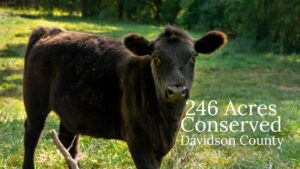
by Crystal Cockman
June 15, 2016
 You may have heard someone say that a certain lizard with a blue tail is a “scorpion,” thought to have a venomous sting. This is false though, as skinks are simply a type of lizard and pretty harmless, though larger ones might hurt if they bite you.
You may have heard someone say that a certain lizard with a blue tail is a “scorpion,” thought to have a venomous sting. This is false though, as skinks are simply a type of lizard and pretty harmless, though larger ones might hurt if they bite you.
One of the more common lizards found with such a blue coloration on the tail is the five-lined skink (Eumeces or Pestiodon fasciatus). They are dark brown in color with five white to yellowish lines that run down their backs and tails. They grow to a length between 5 and 9 inches. They are primarily terrestrial but will climb trees, and are active year-round in warm weather. They occur throughout North Carolina except for the outer banks. Their habitat is broad, occurring anywhere with rotting stumps and logs.
Adult males will tolerate juveniles and females in their territories but actively defend them from other males. Females lay fifteen or so eggs usually in a small cavity under a rotting log or loose bark or similar area. They will take care of the eggs protecting them by covering them with their bodies.
Five-lined skinks can be distinguished from southeastern five-lined skinks by a row of enlarged scales under the tail. They can be distinguished from broadhead skinks by their smaller size and four labial (lip) scales instead of five.
Southeastern five-lined skink (Eumeces or Plestiodon inexpectatus) look very similar to five-lined skinks, but have scales all of similar size underneath their tails. They are brown to black in color with the same five white to yellowish stripes, two on each side and one down the center of their back. Young have a bright blue tail which tends to fade with age. The stripes of males also fade with age, but females retain them.
Found in a broad variety of habitats, southeastern five-lined skinks prefer sandy and dry sites. They feed on a variety of insects, spiders, and other invertebrates. As with many other species of lizard, they will break off their tails when grabbed, which allows them to escape from predators.
Broadhead skinks (Eumeces or Plestiodon laticeps) are the largest skinks in our area, reaching lengths of more than a foot long. They get their name from their wide jaws that give their head a triangular shape. Adult males are brown to olive in color and develop an orange-red head during mating season in the spring. Females have five stripes similar to the five lined and southeastern five lined skinks. Young are dark brown in color with stripes and blue tails.
Broadhead skinks are found across North Carolina with the exception of the northern mountains. They are more likely to be found in trees than other skinks. You’ll see them in urban areas as well as the forest. Females are larger than males, and males will look for a large female to mate with, as they have more eggs. They are territorial as well and will fight other males in their area.
The next time you hear a rustle in the leaves and see a skink you may want to examine it for a closer look to see which species it might be. They can be hard to catch, and watch out for their bite, but don’t be afraid that they will sting you. They are another fun species to spot when walking around in the woods.